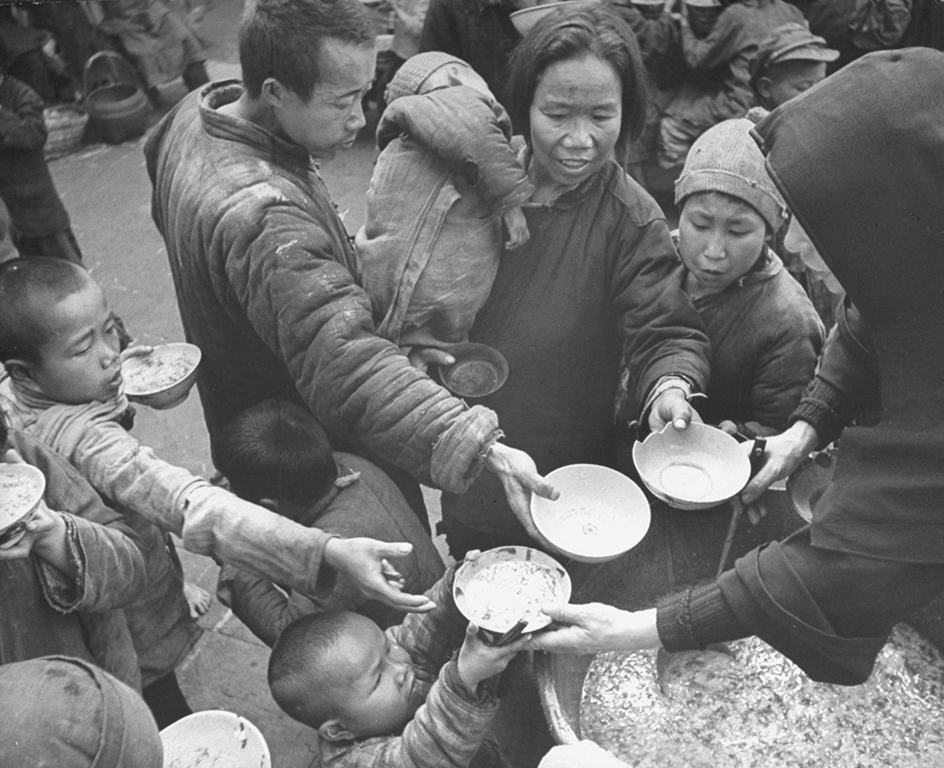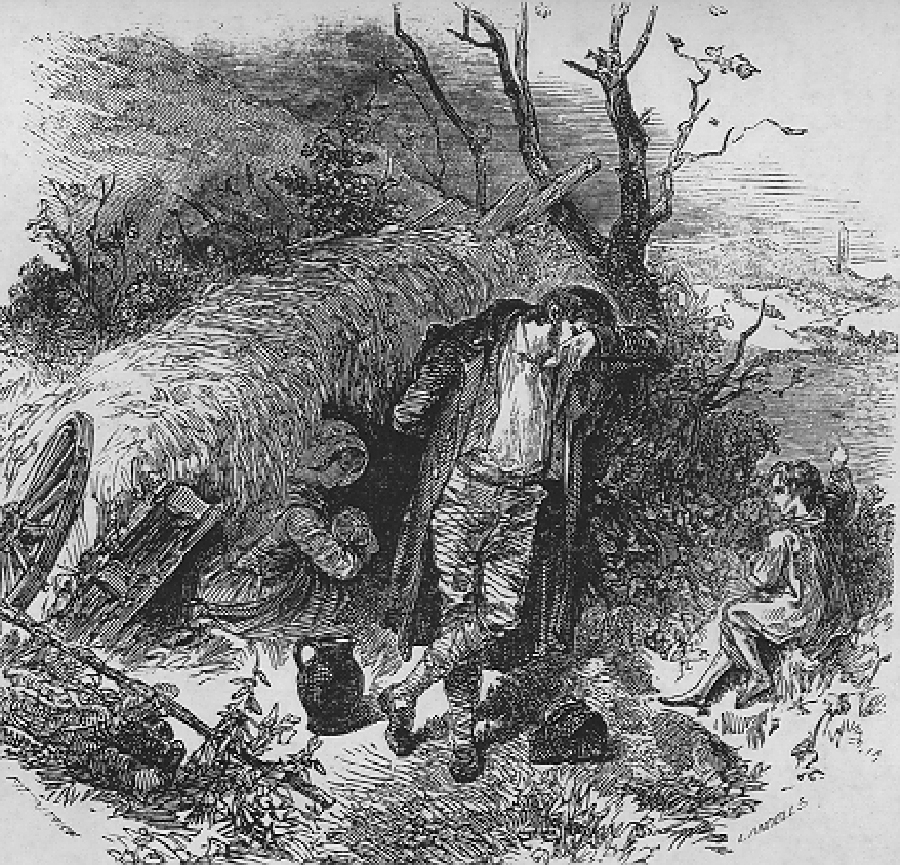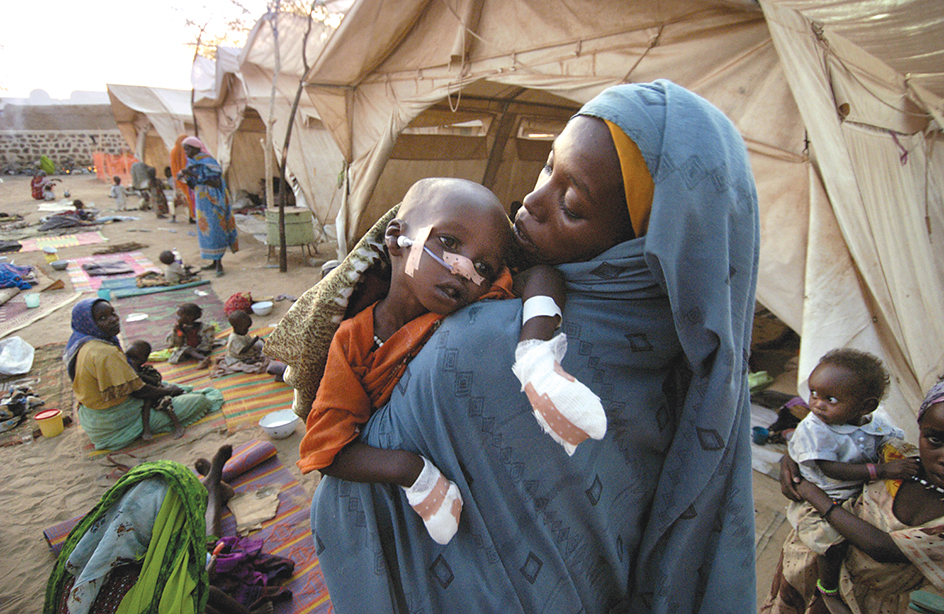Famine is a prolonged food shortage that causes widespread hunger and death. Throughout history, famine has struck at least one area of the world every few years. Most of the developing nations of Africa, Asia, and Latin America have barely enough food for their people. Roughly a half billion people on Earth are seriously malnourished. They either have too little food or eat the wrong food. When food production or imports drop, famine may strike. Thousands or millions of people may die.

Causes of famine
Many famines have more than one cause. For example, the great Bengal famine of 1943 in eastern India was caused by both historical and natural events. World War II created a general food shortage. The war also led to the cutoff of rice imports from Burma (now Myanmar), which was occupied by the Japanese. Then a cyclone destroyed much farmland. Famine struck, and more than 11/2 million people died.
Nearly all famines result from crop failures. The chief causes of crop failure include drought (prolonged lack of rain), too much rainfall and flooding, and plant diseases and pests. Many other factors may also help create a famine.
Drought
ranks as the chief cause of famine. Certain regions of Africa, China, and India have always been those hardest hit by famine. All have large areas near deserts, where the rainfall is light and variable. In a dry year, crops in those areas fail. Famine may strike. In the 1870’s, for example, dry weather in the Deccan Plateau of southern India caused a famine. The famine took about 5 million lives. During the same period, a famine in China killed more than 9 million people.
In the late 1960’s and early 1970’s, lack of rain produced widespread famine in a region of Africa called the Sahel. The Sahel lies just south of the Sahara. Famine again struck this part of Africa and parts of eastern and southern Africa during the mid-1980’s. The famine was especially devastating in Ethiopia. A civil war in that country hampered relief efforts. Since the late 1960’s, millions of Africans have died of malnutrition or hunger-related causes. But many have been saved by international assistance.
Too much rainfall
may also bring famine. Rivers swollen by heavy rains overflow their banks and destroy farmland. Other crops rot in the field because of the excess water. In the 1300’s, several years of heavy rains created widespread famine in western Europe. The Huang He River in northern China is called China’s Sorrow because it often floods. When it floods, it ruins crops and brings famine. In 1929 and 1930, flooding along this river caused a famine that killed about 2 million people.
Plant diseases and pests
sometimes produce famine. During the 1840’s, a plant disease destroyed most of Ireland’s potato crop. As a result, about 1 million people died from starvation or disease. Millions emigrated. Occasionally, swarms of locusts cause widespread destruction of crops and vegetation in the Sahel and other areas of Africa.

Other causes
of famine include both natural and human ones. Such natural disasters as cyclones, earthquakes, early frosts, and tsunamis (sequences of huge, destructive ocean waves) may strike. If they affect a large area, they destroy enough crops to create a famine. War may result in a famine if many farmers leave their fields and join the armed forces. Sometimes, an army deliberately creates a famine to starve an enemy into surrender. The army may destroy stored food and growing crops. It also may set up a blockade to cut off the enemy’s food supply. Blockades prevented food shipments from reaching the Biafra region in the Nigerian civil war (1967-1970). A famine resulted. Over a million Biafrans probably starved.
Poor transportation may also contribute to a famine because of the difficulty of shipping food where it is most needed. Many famines result largely from primitive transportation. A famine in what is now the state of Uttar Pradesh in northern India killed about 800,000 people in 1837 and 1838. Lack of transportation prevented the shipment of grain from other areas of India.
Effects of famine
The chief effects of famine include death and disease, destruction of livestock and seed, crime and other social disorders, and migration.
Death and disease
are the main and most immediate effects of famine. People who lack sufficient food lose weight and grow weak. Many famine victims become so feeble that they die from diarrhea or some other ailment. The weakened condition of a starvation victim is called marasmus. Old people and young children usually are the first to die.
Children who have some food but lack sufficient protein develop a condition called kwashiorkor. One symptom is edema (puffy swelling of the face, forearms, and ankles). Changes in the color and texture of the hair and skin also may occur. Young victims who do not die from kwashiorkor or starvation may grow up with severe mental and physical disabilities.
Famines also increase the possibility of epidemics. Cholera, typhus, and other diseases take many lives because people weakened by hunger do not recover easily from disease. Large numbers of the victims have fled from their homes and live in crowded refugee camps. In such conditions, disease spreads quickly. People frequently must drink impure water, which can carry disease.
Destruction of livestock and seed
during a famine prolongs the disaster. Many farm animals die or are killed for food. Farmers, to avoid starvation, may have to eat all their seed before planting begins. Such losses hinder them from returning to a normal life and may lower production levels.
Crime and other social disorders
increase during a famine. Such crimes as looting, prostitution, and theft multiply. Desperate people steal food and other items they could not obtain otherwise. They may sell stolen goods to buy something to eat. There may be outbreaks of violence, particularly near food distribution centers.
Migration.
Large numbers of famine victims leave their homes. Many people from rural areas flock to cities or refugee camps where food may be available. In the confusion, parents and children may be separated.

Prolonged famine may result in emigration. The Great Irish Famine caused millions of people to settle in other countries, chiefly the United States.
Fighting famine
The United Nations (UN) and several other international organizations provide emergency help for famine victims. Various agencies also work to increase the world’s food supply and thus prevent future famines. Many nations hope to prevent famine by increasing their food production. If a nation can build up a large enough reserve of food, regional crop failures will not cause disastrous shortages. For additional information about world food programs and methods of producing more food, see the World Book articles on United Nations (Fighting hunger) and Food supply (Methods to increase the food supply) (Food supply programs).
If a nation’s population grows as fast as its food production, little food will be left over to build up a reserve. For this reason, many nations have promoted birth control programs to limit their population growth (see Birth control (In other countries)). However, such programs have had limited success in areas where large numbers of people remain poor. Many poor people want large families so the children can help with the work and, later, care for the parents.
